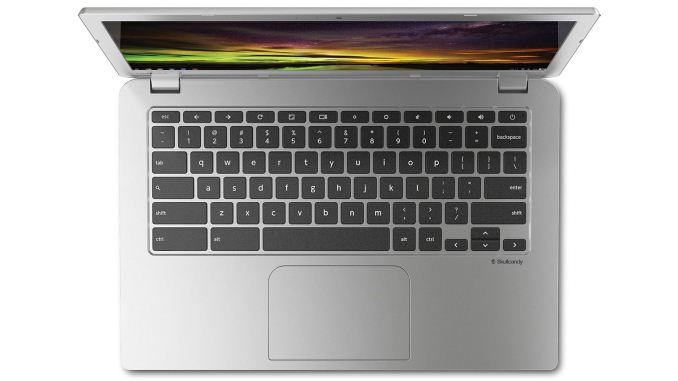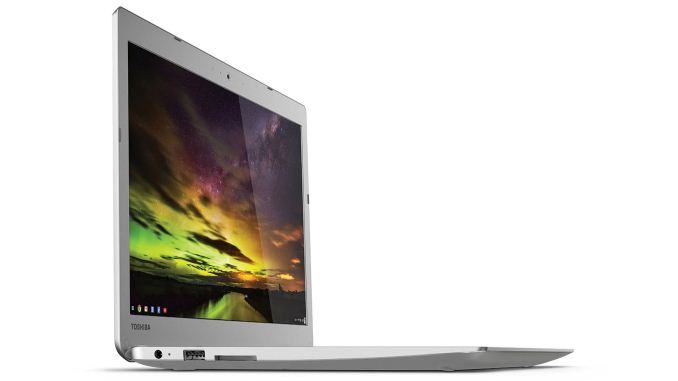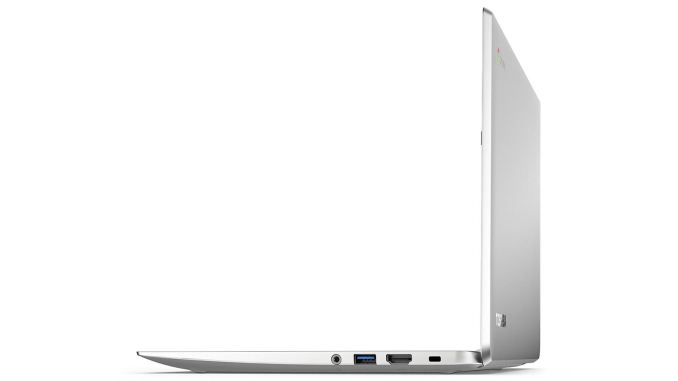Toshiba Chromebook 2: A Feast for the Eyes
by Jarred Walton on February 11, 2015 10:00 AM ESTToshiba Chromebook 2 Subjective Evaluation
Laptops for the most part pretty much live and die by their subjective evaluation. No matter how good the specs might look on paper, if the actual user experience ends up falling short then at best we have a laptop that can only be recommended with some qualifications. For the Toshiba Chromebook 2, the biggest qualification in my book is going to be Chrome OS; if you’re okay with the limitations (and benefits) of Chrome OS, there’s nothing else on the Toshiba Chromebook 2 that’s going to be a problem. Let’s quickly cover the major items in a bit more detail.
Starting with the display, again, it’s awesome. When we get to the raw numbers we’ll find that it’s not perfectly calibrated, but it’s far closer than any other Chromebook we’ve looked at. It also has a great contrast ratio (above 1000:1) and the colors make images and videos a completely different experience compared to something like the Acer Chromebook 13. Just look at these pictures for an example of what I’m talking about:

Toshiba Chromebook 2 1080p on Left; Acer Chromebook 13 1080p on Right.
Using a camera to take a picture of a display is never a great way of doing things, and I did have to Photoshop the images a bit, but even so the results are telling. You can see immediately that the colors are different, even from the front-on view, but what really causes havoc on the Acer LCD is the poor vertical viewing angles. From above the TN display looks washed out, while from below it experiences a horrible color shift even to the point of inversion. The Toshiba with its IPS display doesn’t have either problem. In other words, the display is a winner and if you’ve been looking for a Chromebook with a good display that won’t cost too much (e.g. not the Pixel), this will do quite nicely.
The speakers in the Toshiba Chromebook 2 are decent and can get loud enough that watching YouTube videos in a group setting isn’t a problem. Toshiba partnered with Skullcandy on the speakers, and for a Chromebook this is probably as good as you’ll get. Interestingly, the speakers are fully enclosed in the case with no visible grille (the Acer Chromebook 13 takes a similar approach), but it doesn't seem to affect sound quality negatively, or at least it's no worse than other laptop speakers. The headphone output was also clean and got plenty load.
The keyboard and touchpad for their part work well, though there’s nothing exceptional about them. Key travel is a bit shallow in my opinion, but it’s better than the C720 in overall feel. The touchpad tends to work fine most of the time, but as with the Acer Chromebook 13 there are times where lack of performance can make the touchpad feel sluggish.
Interestingly, some of the worst offenders for sites that feel slow happen to come from Google, with Drive (and Docs, Spreadsheet, etc.) in particular being quite the sluggish experience. Open up AnandTech.com and everything loads and scrolls beautifully, but Drive makes me immediately yearn for a faster system. That’s sort of the irony of the whole Chromebook experience for me: Google’s own cloud-based tools can be some of the most demanding in terms of performance, and yet they’re the tools you’re almost forced to use on Chromebooks, which are frequently underpowered compared to other computing options. Then again, Office 365 running on my Core i7-4770K desktop feels sluggish compared to Office 2010 running on the same system, thanks to the gussied up animations; sometimes, less is more.
Moving on, build quality is decent but pretty much what you’d expect from a $300 laptop. The chassis is primarily made of plastic and if you press hard enough there’s a bit of flex, but nothing to be concerned with for most use cases. (I'm not sure I'd want a bunch of middle school students cramming this sort of laptop into a backpack, though.) It is also interesting to notice the difference in size between the Toshiba Chromebook 2 and the Acer Chromebook 13; both sport 13.3” 1080p displays, but the Acer chassis is about half an inch deeper and wider. I still prefer the feel of the Acer Chromebook 13 keyboard, but it’s really more like a 14” chassis with a 13.3” display, and there’s no real reason for the added size.
We’ve mentioned the performance aspect and wondered if there might be cases where the slow graphics could become a concern. On that subject, while normal 1080p YouTube videos played fine, 1080p60 videos are pretty much out of the question. You’d think simply dropping half the frames could address the problem, but on the 1080p60 videos I tried, stutter was so bad that in some cases frame rate was in the low single digits. 720p60 didn’t have a problem, at least, but that’s less than half the resolution of 1080p60. The Tegra K1 in the Acer CB13 by comparison was able to decode 1080p60 YouTube videos, as was the Haswell-based Celeron 2955U in the Acer C720 (albeit at the integrated screen’s 1366x768 resolution). Perhaps it’s possible to get 1080p60 working better with some additional software/driver updates, but at present you’ll be limited to 1080p30 or 720p60, at least for YouTube videos.
Finally, let’s quickly touch on battery life. Chromebooks in general do well here, and the Toshiba Chromebook 2 is no exception. If you’re looking for a laptop that can last eight hours off the battery, it will suffice. However, the “up to nine hours” is very much the best-case, and it’s probably at 100 nits screen brightness. We’ve tested a few other Chromebooks that do better, and the Acer Chromebook 13 in particular offers a lot more battery life in an otherwise similar package. It could be that the higher quality 1080p IPS display simply uses more power than the 1080p TN panel in the Acer CB13, but more likely is that the Tegra K1 is simply a more efficient SoC.
Overall, from a subjective viewpoint the Toshiba does very well, especially for an inexpensive laptop. There are no show stoppers, and the only potential gripes are going to be the slightly lower than typical battery life as well as the inability to handle certain graphically complex tasks like 1080p60 YouTube content. There are situations where Tegra K1 is clearly the better SoC, though outside of a few edge cases it mostly feels like splitting hairs. For people willing to live within the Chrome OS ecosystem, this is my favorite Chromebook so far, though the upcoming Acer Chromebook 15 still holds a lot of potential.
There’s also still that question of price – the Acer Chromebook 13 gives you basically everything except for a good screen; is the extra $80 for 4GB RAM and a high quality screen worth the cost? On most laptops I’d pay $100 for a good screen in a heartbeat, but here the difference is a 25% increase in price, and for some that will be too much to take. However, when you consider the fact that the screen is the part you interact with the most on a laptop, it’s a justifiable expense, especially for anyone that intends to use the device on a daily basis. There are far worse ways to spend an extra $80 when it comes to upgrading components in a laptop.
Finally, for those interested, along with a complete gallery of our test laptop, we've opened up the chassis to see what's inside the CB35. It's not particularly hard to open the chassis, as you simply need to remove the ten screws on the bottom, but note that two screws are hiding under the pads at the front of the chassis. Once inside, well, there's really not much to do. The RAM and storage aren't user upgradeable, so short of replacing the battery at some point there's no reason to open things up.







_thumb.jpg)
_thumb.jpg)
_thumb.jpg)
_thumb.jpg)
_thumb.jpg)
_thumb.jpg)
_thumb.jpg)
_thumb.jpg)
_thumb.jpg)
_thumb.jpg)
_thumb.jpg)
_thumb.jpg)








66 Comments
View All Comments
tdo51144 - Thursday, February 12, 2015 - link
like itTheJian - Friday, February 13, 2015 - link
"In Octane, Kraken, and SunSpider, the N2840 consistently beats the Tegra K1 and in some cases it even ties (roughly) Apple’s A8X."Umm, isn't nexus 9 running a K1, and beating n2840 here in Octane and Kraken?
"Take NVIDIA’s Tegra K1 SoC, which pairs one of the fastest SoC GPUs with a respectable ARM-based CPU; by contrast, the N2840’s CPU is generally faster than the Tegra K1’s CPU"
Both won 2 of the 4 benchmarks you ran (if comparing to nexus 9 which houses the latest K1 rev), not sure how you say either won. Seems like a tie? But yes, gpu lopsided to NV. I think we'd need Denver in a chromebook before you could say these statements for sure correct? You talk as if there is only ONE version of K1. There's only one version in a chromebook, but it's incorrect to say faster than both K1 versions here. Maybe I'd feel better about the statement if you called it 32bit K1 in this context. I can see you're talking chromebooks, but people may not get that denver simply can't be bought yet in one (or at least note that when saying it). We'll probably see an x1 based chromebook before denver again but still...Since I don't think it will be back until 14nm samsung version that is.
You compare the cpu to apples A8x, so why are you not mentioning the 64bit Denver version of K1 in Nexus9? Apple isn't a chromebook either, but is lopped in the cpu talk. If you hadn't done that, it would be clear you're not comparing cpus from tablets and chromebooks. But with apple you ARE adding tablet cpus to the talk, so why not nexus 9's K1?
JarredWalton - Sunday, February 15, 2015 - link
Technically the Nexus 9 is the Tegra K1-64, or more commonly referred to as Denver. Of course, Denver has its own pros and cons, with performance sometimes being quite a bit slower due to the way the binary translation works. I'm not super hung up on which CPU is fastest by 5-10%; it's merely interesting to see Bay Trail Atom doing reasonably well. K1-32 and A8X are both more power efficient however, which is at least as important as raw performance.But you're missing the real point, which is that as slow as the N2840 is, it's as fast as (faster than) the top smartphone SoCs. And yet the slowest Haswell-U processor runs circles around N2840. And the 2955U does that without really sacrificing a lot of battery life. I'm super interested in the 3205U, as you might guess.
LazarusNine - Friday, February 13, 2015 - link
@JarredWalton Excellent review. Informative and useful for comparison. I would very much like to see a review of the Windows 'chromebook', the Acer ES1-111M, or one of its variants. It is very similar to the HP Stream 11, but with upgradeable RAM, it makes for an interesting contender in the sub $200 range.benelux - Saturday, February 14, 2015 - link
This was a really nice article, thanks. Would you mind providing the vintage of your benchmark results? That 5440 Octane score for the HP Chromebook 11 looks dated. My girlfriend's HP Chromebook 11-1101 is on Chrome 41 the current beta release. I get octane scores that average around 6800 on it. My 2013 Samsung Chromebook X303C12 has very similar hardware. It has the same SOC, the same display resolution, and the same 2G ram and 16 GB SSD. My Samsung is on Chrome 40 stable. It has Octane scores above 6400.I realize you might not have all the devices lying around to retest, but if you could indicate when a test was done and on what release that would be great. Chrome OS is very much a moving target. My Samsung Chromebook had Octane scores in the mid-3000 range when it came out in Q4 2013. Now it's in the mid-6s.
benelux - Saturday, February 14, 2015 - link
Correction: the Samsung Chromebook came out in fall 2012, not 2013.JarredWalton - Sunday, February 15, 2015 - link
You're right: some of the scores are quite old. The only recent scores for Chromebooks are the two Acers (C720 and CB13) and the Toshiba; everything else is probably at least a year old. I hope to retire some of the results soon and replace them with more recent offerings.realwarder - Monday, February 16, 2015 - link
Is this a paid article? It sounds very pro-Chrome OS, which given the severe limitations of that OS seem to skip over that completely and even mention it as a benefit.Given that an end-user are basically buying a web browser with no ability to do simple things like print or work offline, it's a lot of money for a pretty worthless PC. It only has 16GB storage (or whatever is left of that).
There are cheaper and more capable PCs around these days running Windows that provide so much more functionality. If all you do want is a portable web browser, there are many tablets that provide more for less too.
JarredWalton - Monday, February 16, 2015 - link
The Windows alternatives have garbage displays, and while you *can* run the stripped down version of Windows on 32GB of storage, it's not comfortable to do so. Chrome OS also boots faster and stays peppier than Windows in general with limited resources. It's so far the best Chromebook in my opinion, but would I personally want to do all my work on it? No, because Chrome OS has plenty of limitations. I covered those extensively in a previous article, and rather than trot out the same content every time I just link back to the relevant review. Like this:http://www.anandtech.com/show/8928/acer-chromebook...
Christopher1 - Tuesday, February 17, 2015 - link
Chrome OS is a waste. It is not as 'fully featured' as Windows 8.1 even and is not able to do a lot of the things that Windows 8.1 can do.Such as full-featured multimedia viewing. Such as even low-end ACDSee Pro-esque photo viewing and editing.
Need I keep on going? Chrome OS is a toy to the most 'in the know' out there today and just is not going to overtake even iOS for most people.
Give me a cheap 400 dollar Windows laptop for each of my children and they are pretty much golden.
It can do nearly ANYTHING save for high-end, last 5 year AAA gaming.